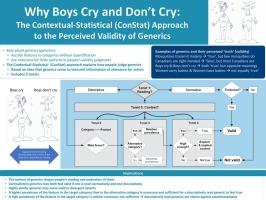男孩为什么哭和不哭:情境统计(ConStat)方法对通用的感知有效性。
IF 2.8
1区 心理学
Q1 PSYCHOLOGY, EXPERIMENTAL
引用次数: 0
摘要
人们以一种出了名的善变的方式来判断仅仅是复数的一般性概括(简称“一般性”,例如,“女人是有同理心的”)的有效性。我们提出了上下文统计(ConStat)框架来解释这些判断,表明它们遵循一致的原则,因此是逻辑和可预测的。恒常建立在泛型传递与行动相关的信息的假设之上。它由五个信条组成。(1)人们可以将泛型理解为规范性的或描述性的。如果他们认为一个通用的规范,他们会支持或拒绝它——这个决定可能伪装成一个真理判断,即使“真理”这个概念只适用于人们认为一个通用的描述。(2)人们可以将描述性阅读的通则理解为主要关于类别或主要关于特征。(3)人们通过充当直觉统计学家来判断描述性阅读的共性是否正确,默认情况下,他们会考虑目标类别与替代类别相比特征在该类别中的流行程度;只有当另一个类别在认知上不可用时,他们才会根据目标类别中该特征的流行程度来判断。(4)通用语的明示和隐含内容决定了通用语的普遍性必须超过的阈值才会感觉真实。(5)原则(1)到(4)中描述的过程都是由通用的上下文形成的。康斯坦特框架解释了真理判断中的许多变化无常的模式,为人们如何理解泛型的研究激发了新的方向,并提出了改进研究方法的方法。本文章由计算机程序翻译,如有差异,请以英文原文为准。

Why boys cry and don't cry: The Contextual-Statistical (ConStat) approach to the perceived validity of generics
People judge the validity of bare plural generic generalizations (‘generics’ for short, e.g., ‘Women are empathic’) in a notoriously fickle way. We present the Contextual-Statistical (ConStat) framework to explain these judgments, showing that they follow consistent principles and are therefore logical and predictable. ConStat rests upon the assumption that generics transmit information of relevance for action. It consists of five tenets. (1) People may understand generics as being meant normatively or descriptively. If they deem a generic normative, they endorse or reject it – a decision that may masquerade as a truth judgment even though the concept ‘truth’ applies only when people deem a generic descriptive. (2) People can understand a descriptively read generic as being primarily about the category or primarily about the feature. (3) People judge whether a descriptively read generic is true by acting as intuitive statisticians who consider, by default, the prevalence of the feature in the target category as compared to an alternative category; only if an alternative category is cognitively unavailable, they base their judgment on the prevalence of the feature in the target category. (4) Both the explicit and implied content of the generic determine the threshold that the prevalence must exceed for the generic to feel true. (5) The processes described in tenet (1) to (4) are all shaped by the generic's context. The ConStat framework explains many fickle patterns in truth judgments, inspires novel directions for research on how people understand generics, and suggests manners to improve the methodology of that research.
求助全文
通过发布文献求助,成功后即可免费获取论文全文。
去求助
来源期刊

Cognition
PSYCHOLOGY, EXPERIMENTAL-
CiteScore
6.40
自引率
5.90%
发文量
283
期刊介绍:
Cognition is an international journal that publishes theoretical and experimental papers on the study of the mind. It covers a wide variety of subjects concerning all the different aspects of cognition, ranging from biological and experimental studies to formal analysis. Contributions from the fields of psychology, neuroscience, linguistics, computer science, mathematics, ethology and philosophy are welcome in this journal provided that they have some bearing on the functioning of the mind. In addition, the journal serves as a forum for discussion of social and political aspects of cognitive science.
 求助内容:
求助内容: 应助结果提醒方式:
应助结果提醒方式:


